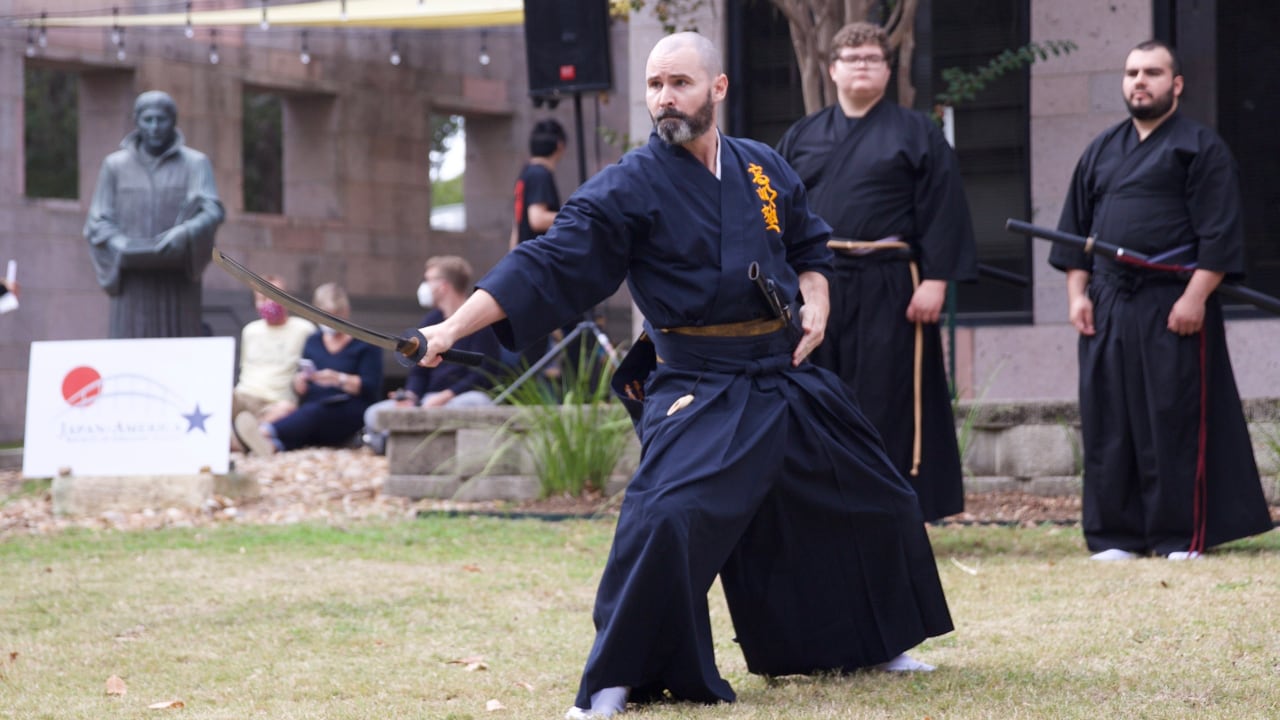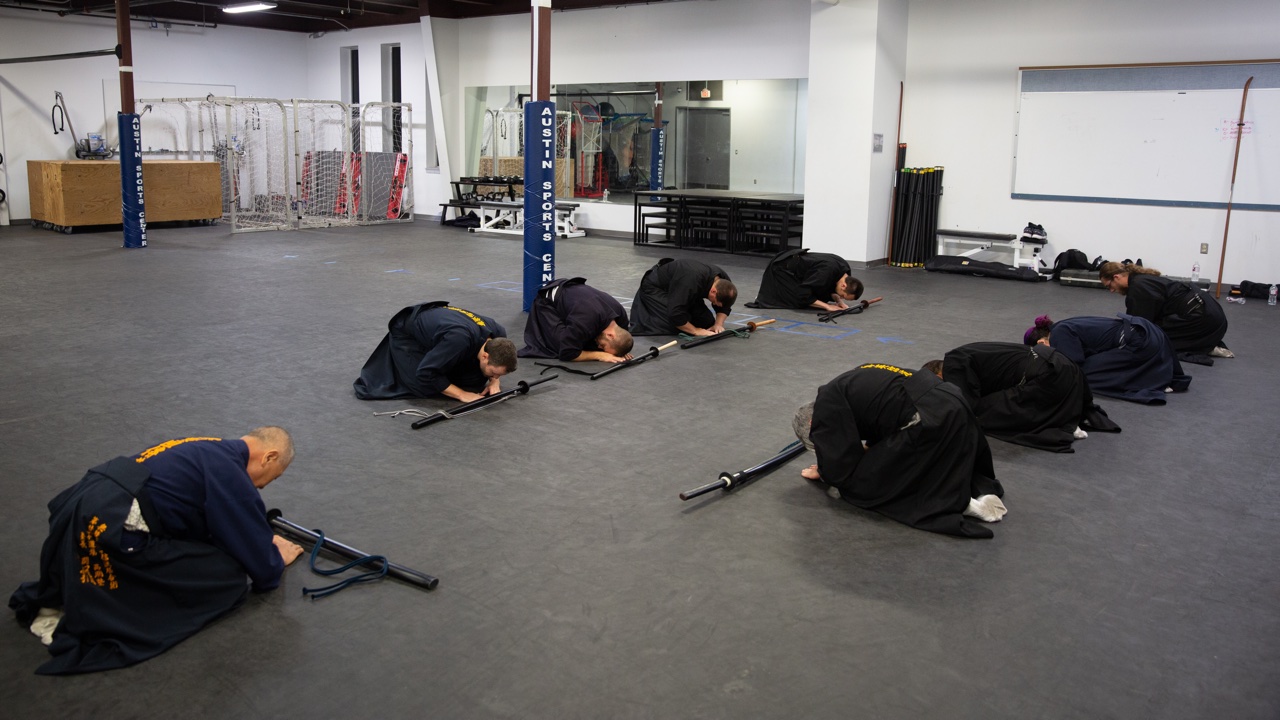History
Muso Jikiden Eishin-ryu (無雙直傳英信流居合術) translates to “peerless, direct transmission, school of Eishin”. It one of the oldest martial art from Japan with a history of 450 years that was founded in the late Muromachi period (late 16th century). The founder of Muso Jikiden Eishin-ryu was Hayashizaki Jinsuke Shigenobu. It is said he confined himself for approximately a hundred days in the Hayashizaki Myojin Shrine, where he received divine inspiration for a new body of sword techniques using a long sword. Since then, multiple lines have evolved.
The term ‘Eishin’ came from 7th generation headmaster, Hasegawa Chikaranosuke (Mondonosuke) Eishin. His technique, was so miraculous that it was called Hasegawa Eishin Ryu, and later became recognized as Muso Jikiden Eishin-ryu. He also served the Tokugawa family in Nagoya and excelled in Kyudo.
The 9th generation headmaster, Hayashi Rokudayu Morimasa, served the Tosa domain and established Eishin-ryu there. Since then, the Tosa Domain kept his techniques as house secrets and passed the knowledge on to succeeding generations.
The 17th generation headmaster, Oe Masamichi Shikei formalized many of the waza in Muso Jikiden Eishin Ryu. He changed the names of the Omori-ryu and Hasegawa-ryu, (both styles were integrated into Eishin-ryu at the time) into Seiza no Bu and Tatehiza no Bu. Masamichi also organized the waza into logical order within each set. He was concerned that budo would decline and decided to open the gate and disseminate the techniques widely.
Yamauchi Toyotake, the 18th generation headmaster is the grandson of Yamauchi Yodo, the daimyo of Tosa. Yamauchi Toyotake taught many students in Tokyo and Kyoto and even served when called to do military service in 1941.
The 19th generation, Kono Kanemitsu, founded the Meibukan in Toshima-ku, Tokyo. The 20th generation, Onoe Masamitsu, inherited it and passed it to the current 21st generation, Sekiguchi Komei.
The current (21st) generation is lead by Sekiguchi Komei sensei. He created the Komei Jyuku, also known as the Nihon Koden Bujutsu Iaido Renmei, which is a member of the Nihon Kobudo Kyokai. Sekiguchi sensei teaches and spreads Iaijutsu with isshin / one heart (一心) philosophy. When we use the sword, our school methodology is to handle a long sword like a short one, and a heavy sword like a light one.
Lineage
- Hayashizaki Jinsuke Shigenobu
- Tamiya Heibei Shigemasa
- Nagano Muraku Nyudo Kinrosai
- Momo Gunbei Mitsushige
- Arikawa Shozaemon Munetsugu
- Banno Danemon no Jo Nobusada
- Hasegawa Chikaranosuke Eishin (Hidenobu)
- Arai Seitetsu Kiyonobu
- Hayashi Rokudayu Morimasa
- Hayashi Yasudayu Yasumasa
- Oguro Motoemon Kiyokatsu
Tanimura-Ha
- Hayashi Masu no Jo Masanari
- Yoda Manzo Yorikatsu
- Hayashi Yadayu Masayori
- Tanimura Kame no Jo Yorikatsu
- Goto Magobei Masasuke
- Oe Masamishi
Yamauchi-Ha
- Yamauchi Toyotake
- Kono Kanemitsu
- Onoue Masamitsu
- Sekiguchi Komei
Waza
Shoden Seiza no Bu
- Mae
- Migi
- Hidari
- Ushiro
- Yaegaki
- Ukenagashi
- Kaishaku
- Tsukekomi
- Tsukikage
- Oikaze
- Nukiuchi
Chuden Tatehiza no Bu
- Yokogumo
- Toranoissoku
- Inazuma
- Ukigumo
- Oroshi
- Iwanami
- Urokogaeshi
- Namigaeshi
- Takiotoshi
- Makko
Okuden Tachi Waza no Bu
- Yukizure
- Tsuredachi
- Somakuri
- Sodome
- Shinobu
- Yukichigai
- Sodesurigaeshi
- Moniri
- Kabezoe
- Ukenagashi
- Ittomagoi Ichi
- Ittomagoi Ni
- Ittomagoi San
Okuden Suwari Waza
- Kasumi
- Sunegakoi
- Tozume
- Towaki
- Shihogiri
- Tanashita
- Ryozume
- Torabashiri
Kumitachi
Nanahon no kata
- Deai
- Kobushidori
- Zetsumyoken
- Dokumyoken
- Tsubadome
- Ukenagashi
- Mappo
Tsumeai
- Hasso
- Kobushidori
- Iwanami
- Yaegaki
- Urokogaeshi
- Kuraiyurumi
- Tsubamegaeshi
- Gansekiotoshi
- Suigetsuto
- Kazumiken
- Uchikomi
Toho and Bangai
Toho Waza
- Mae
- Zengogiri
- Kiriage
- Shihogiri
- Kissakigaeshi
Toryu Bangai
- Mae
- Aranami
- Kesaguruma
- Takiguruma
- Tatsumaki
Bangai
- Hayanami
- Raiden
- Jinrai
 Austin Komei Jyuku
Austin Komei Jyuku

